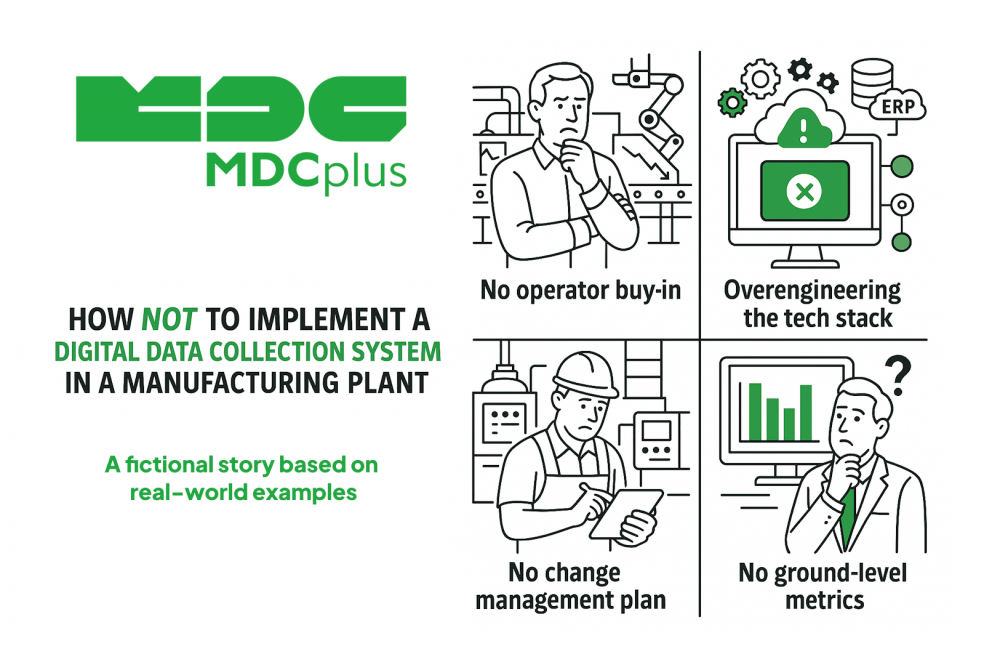No more manufacturing downtimes
Get started with your projectHow Not to Implement a Digital Data Collection System
Let’s walk through a fictional but highly relatable story — a showcase of bad decisions, where they led, and what we can all learn from them.
The Beginning: A Solution in Search of a Problem
Mistake #1: Starting with the tech, not the problem
The leadership team at Plant X was sold a sleek data collection solution at a trade show. The system promised real-time OEE dashboards, predictive maintenance alerts, and cloud integration.
What no one asked was:
“What are we trying to fix?”
There was no gap analysis, no performance benchmarking, and no clear business objective. The system was bought because it sounded transformative — not because it solved a defined problem.
Result: Six months in, managers still couldn’t articulate the ROI.
Ignoring the People
Mistake #2: No operator buy-in, no process integration
The implementation team dropped tablets on every machine without talking to the people who run them. Operators were expected to enter data manually, with no clarity on why, what for, or how it helped them.
Some were logging random values. Some refused to engage. Others went back to paper logs quietly.
Result: Inconsistent data, constant complaints, and growing skepticism on the shop floor.
Overengineering the Tech Stack
Mistake #3: Complexity over usability
Instead of starting simple, the team pushed for a full-blown MES with all the bells and whistles — ERP integration, machine connectivity, and advanced analytics. But they underestimated the shop floor’s tech maturity and network reliability.
Basic issues like fluctuating Wi-Fi and untrained users brought the system to its knees.
Result: Dashboards full of errors, machines offline from the system, and IT overwhelmed.
No Change Management Plan
Mistake #4: Assuming adoption is automatic
There was no training roadmap. No change champions. No feedback loop. The system was treated like an IT project, not an operational shift. And when it didn’t work smoothly, blame games started.
Result: Finger-pointing between IT, production, and leadership. Morale dropped. The system was branded a failure.
No Ground-Level Metrics or Success Criteria
Mistake #5: No KPIs tied to business outcomes
Leadership expected improved productivity and visibility, but never defined baseline metrics or tracking methods. The dashboards looked fancy, but no one could answer: “Has this improved uptime or reduced scrap?”
Result: No ability to justify the investment. The system sat underused, slowly fading into irrelevance.
Where It All Led
- Hundreds of hours lost in rework and confusion
- Disillusioned workforce, less trusting of future tech initiatives
- A leadership team wary of spending further on digital tools
- And most damaging: the narrative that “digital doesn’t work here.”
How to Avoid the Same Fate
- Start with a clearly defined business problem
Understand the bottlenecks. Quantify the impact of not solving them. - Design with the user in mind
Involve operators from day one. Build trust and demonstrate how the system helps them. - Don’t overbuild — start small, prove value
Begin with a pilot. Make sure it works. Then scale. - Treat it as an organizational change, not an IT upgrade
Assign change champions, plan for training, and build feedback loops. - Measure what matters
Set clear, operational KPIs that connect data collection to real-world outcomes.
Final Thought
Digital systems don’t fail because of technology. They fail because of poor design, poor communication, and poor alignment with reality on the ground.
Before you implement your next system, ask yourself:
“Are we building something people will actually use — and benefit from?”
About MDCplus
Our key features are real-time machine monitoring for swift issue resolution, power consumption tracking to promote sustainability, computerized maintenance management to reduce downtime, and vibration diagnostics for predictive maintenance. MDCplus's solutions are tailored for diverse industries, including aerospace, automotive, precision machining, and heavy industry. By delivering actionable insights and fostering seamless integration, we empower manufacturers to boost Overall Equipment Effectiveness (OEE), reduce operational costs, and achieve sustainable growth along with future planning.
Ready to increase your OEE, get clearer vision of your shop floor, and predict sustainably?
